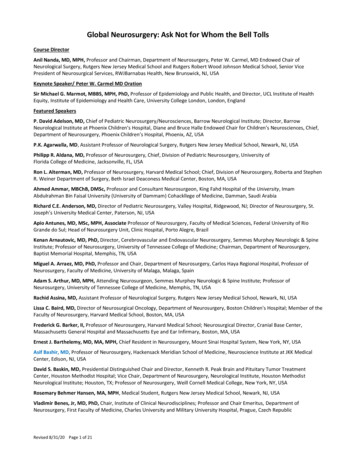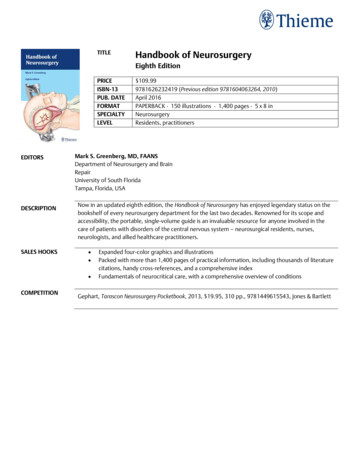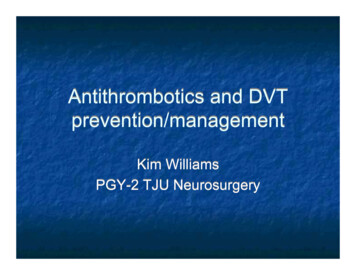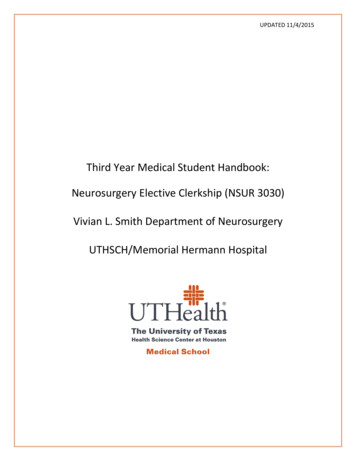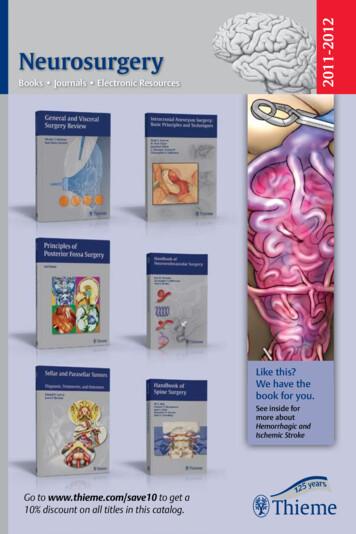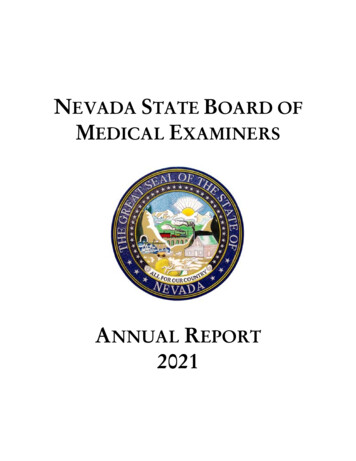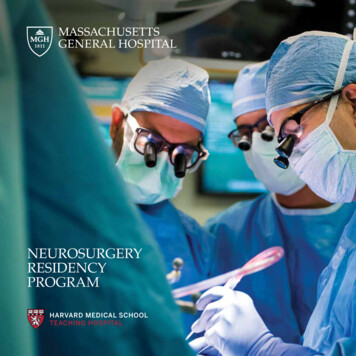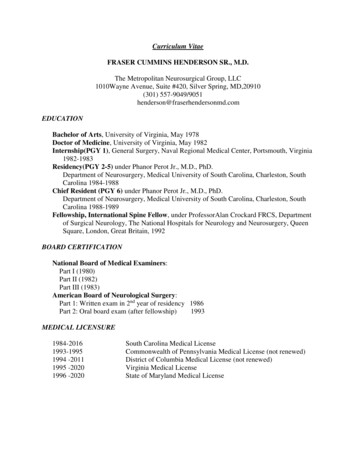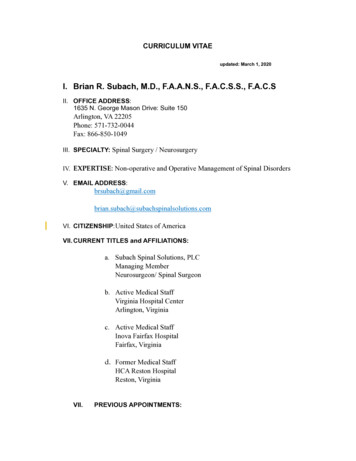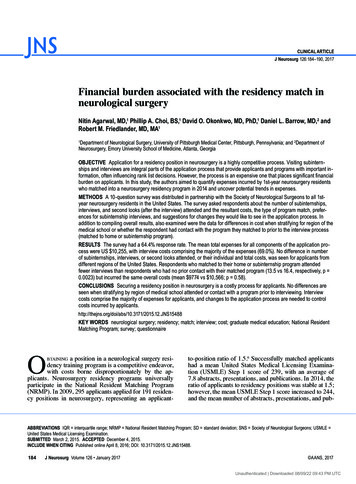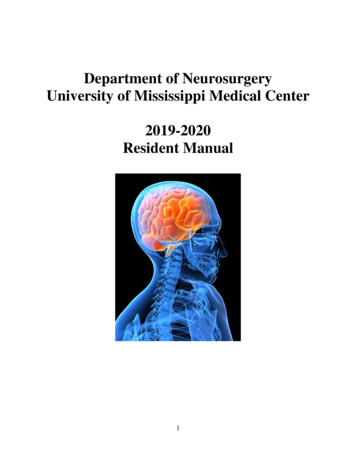
Transcription
Department of NeurosurgeryUniversity of Mississippi Medical Center2019-2020Resident Manual1
TABLE OF CONTENTS1.2.PROGRAM DESCRIPTION DUCATIONAL GOALS AND rall Educational GoalsGeneral Learning Objectives for all UMC RotationSpecific Competency-Based Goals & Objectives for All Clinical Rotations by PGY Level3.Milestones ---------------------474.RESEARCH ----------69Project RequirementsProject SelectionGuidelinesResearch Proposal FormatFundingSubmissions and PresentationsFailure to --------------------------------------72Journal ClubM & M ConferenceGrand RoundsResidents’ Basic Science Lecture and Board PreparationClinical ConferenceMultidisciplinary Conference5.RESIDENT EVALUATION ionsEvaluation CriteriaFeedback of ResultsPromotion of ResidentsProbationary Status, Suspension, and DismissalProcedure for Appeal and Grievance2
6.PROGRAM -------837.POLICIES -------------------84Duty HoursResident SupervisionLab CoatsProfessional AttireBenefits (A complete description is available from Human Resources)MealsWork EnvironmentSexual HarassmentSubstance Abuse and Mental HealthCounselingLibraryMoonlightingLicensure, Credentials and membershipsSubscriptionsResearch StudiesLeaveEducational FundPresentation TravelResident SelectionConflict of InterestLost/Stolen PagersResident Transfers and RehiringMust Call PolicyVerbal Order PolicyContinuity of Care/Hand-Off PolicyConsultation PolicyPolicy on Supervision of Patient CarePolicy on Interaction with Industry Representatives8.CLINICAL --------------110Medical RecordsAppointment Scheduling and ER Follow-ups3
Surgery SchedulingIdentificationHand CleaningBilling IssuesFollow-up IssuesEmployee CounselingPhone Message ReturnNew PatientsSample PharmaceuticalsCall ScheduleICU Bed RequestsCommunication with Outside PhysiciansComplianceResident Case DistributionRoundsOperatingClinicsGeneral CareSafetyHousekeepingLifesaversScholarly ActivityADDENDUM:FORMS --------------------------------120RRC UPDATES (CASE LOG ----------1214
INTRODUCTIONI wish to take this opportunity to welcome you to this Neurosurgical Residency.You have made a serious commitment and investment in your education by entering into this residency. Thechallenges of the anatomy and physiology of the central nervous system are formidable. Dealing with thediseases of your patients, as well as developing neurosurgical techniques will be a continuous life long process.As Program Director and with the commitment of the faculty, I pledge to you an unceasing effort to help youdevelop into a highly trained surgeon. We will challenge you to explore the frontiers of neuroscience, as wellas the management of neurological diseases.I know that we are preparing you for future practices in neurosurgery with capabilities that will allow you tointerface with computer technology, molecular biologic sciences as well as the ewer discoveries in theneurosciences.This handbook was prepared to provide guidelines to assist you during your residency. Read and familiarizeyourself with these guidelines; you are responsible for all materials in this manual and will be held accountablefor this information. These requirements are necessary to allow us to run an orderly and effective residencyprogram.Sincerely,Gustavo Luzardo, M.D.Program Director5
1. Residency Program DescriptionPGY 1/Intern:For neurosurgery residents entering at the intern level, we offer a neurosurgical internship that meets theACGME requirements of acquisition of fundamental clinical skills. Specific rotations vary from year to yearbased on the intern’s needs and the quality of available rotations. Surgical rotations typically include ENT,Trauma and Plastic Surgery. The Neurology requirements for neurosurgery residents are met during this yearwith a rotation on Inpatient/Consults and Neuro Intensive Care. Neuro Intensive Care rotations are generallyincluded within this year. In addition to rotating on ENT, Plastic Surgery or Trauma, the intern will spend threemonths on the Neurosurgical service.In all cases, junior residents are expected to:a. Work under supervision of, and in consultation with, senior residents or faculty members, and notIndependently, without consultation or instructions.b. Should be committed to continuous scheduled reading.c. Should attend all teaching conferences.d. Should participate and take full advantage of any opportunity to work with Faculty on scholarlyactivitiese. Contribute to the education medical students, fellows, rotating residents, advanced practitioners etc.f. Unless unable, attend clinics with the relevant faculty member.g. Participate on the regular call schedule.h. Comply with all requirements, such as logging of duty hours, continuous medical education and hospitalcompliance, to participate in performance improvement projects, etc.i. The PGY specific goals and objectives are as outlined on the Subspecialty End of Rotation EvaluationInstruments. Each resident should demonstrate progression within that framework, and performance atleast “appropriate” for his / her level.j. Residents should exhibit progression on the Neurosurgical Milestones 2.0.PGY 2/Junior Resident:The resident at this level spends 12 months of clinical neurosurgery on the cranial, spine/trauma and/or pediatricneurosurgery service depending on the rotation schedule, which are in six (6) month blocks. The PGY 2resident works under the supervision of the chief resident and faculty, and not independently, at the UniversityHospital. During this year he/she is expected to be involved in all aspects of the patient care, including workup, diagnostic studies, treatment, post surgical management etc. Should become familiar with basic historygathering and performing physical examination, as well as to determine appropriate diagnostic studies, and ableto perform basic bedside procedures (shunt tap, EVD, LP). He/she performs minor surgical procedures underdirect supervision of senior residents or faculty. This resident is actively involved in intensive neurosurgicalcritical care, monitoring techniques and post-operative patient management under the supervision of the chiefresident and faculty. He/she is involved in conference presentations and student teaching. During the pediatricrotation, the junior resident works under the supervision of the attending staff responsible for the pediatricneurosurgical patients. He/she is involved in the admission and work-up of all pediatric patients. He/she assistsand performs surgical procedures in the operating room to the level of his/her abilities. This resident isresponsible for the pediatric neurosurgical clinics, including craniofacial, brain tumor and spina bifida clinics.In all cases, junior residents are expected to:a. Work under supervision of, and in consultation with, senior residents or faculty members, and not workindependently without consultation or instructions.b. be committed to continuous scheduled reading.c. attend all teaching conferences.6
d. participate and take full advantage of any opportunity to work with faculty on scholarly activitiese. Contribute to the education medical students, fellows, rotating residents, advanced practitioners etc.f. Unless unable, attend clinics with the relevant faculty member.g. Participate on the regular call schedule.h. Comply with all requirements, such as logging of duty hours, continuous medical education, and hospitalCompliance, participate in performance improvement projects, etc.i. The PGY specific goals and objectives are as outlined on the Subspecialty End of Rotation EvaluationInstruments. Each resident should demonstrate progression within that framework, and performance at least“Appropriate” for his / her level.j. Residents should exhibit progression on the Neurosurgical Milestones 2.0.PGY 3/Junior Resident:The resident at this level spends 12 months on clinical neurosurgery on the cranial, spine/trauma and/orpediatric neurosurgery service depending on the rotation schedule, which are in four (6) month blocks. ThePGY 3 resident continues on the above services. His/her responsibilities and expectations become somewhatmore advanced as he/she develops basic competency in the care of both adult and pediatric patients. The PGY3 junior resident will spend more time in the operating room on each service.In all cases, junior residents are expected to:a. Work under supervision of, and in consultation with, senior residents or faculty members, and notb. independently without consultation or instructions.c. be committed to continuous scheduled reading.d. attend all teaching conferences.e. participate and take full advantage of any opportunity to work with Faculty on scholarly activitiesf. Contribute to the education medical students, fellows, rotating residents, advanced practitioners etc.g. Unless unable, attend clinics with the relevant faculty member.h. Participate on the regular call schedule.i. Comply with all requirements, such as logging of duty hours, continuous medical education, hospitalcompliance, participate in performance improvement projects, etc.k. The PGY specific goals and objectives are as outlined on the Subspecialty End of Rotation EvaluationInstruments. Each resident should demonstrate progression within that framework, and performance at least“appropriate” for his / her level.l. Residents should exhibit progression on the Neurosurgical Milestones 2.0.PGY 4 / Mid Level Resident:The resident at this level spends at least 6 months on the neurosurgical adult service, and up to six months onrotation on NewSouth Spine / Baptist hospital. The resident assumes a leading role on the adult and pediatricneurosurgical services. This year is dedicated to development of advanced diagnosis, management skills andwill more directly be responsible during the day of any surgical case that is not covered by any chief or seniorlevel resident. The resident more directly will approach faculty directly on cases, especially during the day,although always after communicating with the Chief Resident. This resident is expected to evaluate patients,device and initiate treatment plans, and to be responsible for any operative intervention of these neurosurgicalpatients, after consultation with Chief Resident or Faculty. A great portion of the surgical experience could be atthe “Leading Surgeon” level. During this year, the resident is expected to take a more active teaching role in theweekly basic science/board review conference. This year offers more opportunity to attend conferences held atUMMC and in the community in related disciplines such as Neurology, Neuropathology and Neuro-radiology.7
In all cases, the mid level resident is expected to:a. Work under supervision of, and in consultation with, senior residents or faculty members.b. Should be committed to continuous scheduled reading.c. Should attend all teaching conferences.d. Should participate and take full advantage of any opportunity to work with Faculty on scholarly activitiese. Contribute to the education medical students, fellows, rotating residents, advanced practitioners etc.f. Unless unable, attend clinics with the relevant faculty member.g. Participate on the regular call schedule.h. Comply with all requirements, such as logging of duty hours, continuous medical education, hospitalcompliance, participate in performance improvement projects, etc.i.The PGY specific goals and objectives are as outlined on the Subspecialty End of Rotation EvaluationInstruments. Each resident should demonstrate progression within that framework, and performance at least“appropriate” for his / her level.j. Residents should exhibit progression on the Neurosurgical Milestones 2.0.PGY 5/Senior Resident:The resident is expected to work towards completion of research projects. This is in essence, their “research”year. The resident will enjoy protection from clinical duties, except for coverage of occasional callresponsibilities for absent residents, vacations etc., thus allowing time for dedicated work on scholarlyactivities, research projects, travel to educational conferences, etc. The residents are actually encouraged totravel to educational activities.Residents may become involved in ongoing research or develop novel research protocols. Projects are typicallycarried out with mentorship and laboratory support from one of the established basic science labs at UMMC.Residents are also encouraged to initiate clinical science projects of personal interest. Clinical rotations could bearranged during this year to fulfill any existing requirements, especially if the resident has already demonstratedattainment of many of the goals set for this particular year, beforehand.In all cases the Mid level residents are expected to:a. Work under supervision of, and in consultation with, senior residents or faculty members.b. Should be committed to continuous scheduled reading.c. Should attend all teaching conferences.d. Should participate and take full advantage of any opportunity to work with Faculty on scholarly activitiese. Contribute to the education medical students, fellows, rotating residents, advanced practitioners etc.f. Comply with all requirements, such as logging of duty hours, continuous medical education, hospitalcompliance, participate in performance improvement projects, etc.g. The PGY specific goals and objectives are as outlined on the Subspecialty End of Rotation EvaluationInstruments. Each resident should demonstrate progression within that framework, and performance at least“appropriate” for his / her level.h. Residents should exhibit progression on the Neurosurgical Milestones 2.0.PGY 6/Chief Resident:Given the 1-2-1-2-1-2 character of our resident compliment, generally rotations will be assigned on an 8-monthtimeframe. The resident at this level spends 8-month rotations on Pediatrics, Spine and Cranial services, at theChief level. The PGY 6 resident assumes all chief resident responsibilities as the administrative resident of theentire pediatric or adult program. Resident’s responsibilities include organizing and scheduling of teachingconferences, teaching residents and medical students, and scheduling presentation of patients to attendingphysicians and consultants. Educational programs such as journal clubs, grand rounds, and special lectures are8
the responsibility of this resident. At this level of training, the resident is expected to perform complexprocedures, at the “Leading Surgeon” level. The resident is expected to be the main participant in all scheduledsurgical cases.In all cases senior residents are expected to:a. Work under supervision of, and in consultation with, senior residents or faculty members.b. Should be committed to continuous scheduled reading.c. Should attend all teaching conferences, if not committed on an emergent surgical procedure.d. Should participate and take full advantage of any opportunity to work with Faculty on scholarly activitiese. Contribute to the education medical students, fellows, rotating residents, advanced practitioners etc.f. Unless unable, attend clinics with the relevant faculty member.g. Participate on the regular call schedule at the senior level.h. Comply with all requirements, such as logging of duty hours, continuous medical education, hospitalcompliance, participate in performance improvement projects, etc.i. The PGY specific goals and objectives are as outlined on the Subspecialty End of Rotation EvaluationInstruments. Each resident should demonstrate progression within that framework, and performance at least“appropriate” for his / her level.j. Residents should exhibit progression on the Neurosurgical Milestones 2.0.PGY 7:All residents beginning July 1, 2013 are in an accredited 7-year neurosurgery residency-training program. The7th year will either be a chief year or if the chief year is completed prior to the 7th year, the resident may use thefinal year for additional enfolded fellowship training at the discretion of the program director. All residentswho began their residency before July 1, 2013 may use the 7th year for additional training or may move into aninstructor position at the discretion of the program director. The resident is expected to be the main participantin all scheduled surgical cases, at the “Leading Surgeon” level.In all cases senior residents are expected to:a. Work under supervision of, and in consultation with, senior residents or faculty members.b. Should be committed to continuous scheduled reading.c. Should attend all teaching conferences, if not committed on an emergent surgical procedure.d. Should participate and take full advantage of any opportunity to work with Faculty on scholarly activitiese. Contribute to the education medical students, fellows, rotating residents, advanced practitioners etc.f. Unless unable, attend clinics with the relevant faculty member.g. Participate on the regular call schedule at the senior level.h. Comply with all requirements, such as logging of duty hours, continuous medical education, hospitalcompliance, participate in performance improvement projects, etc.i. The PGY specific goals and objectives are as outlined on the Subspecialty End of Rotation EvaluationInstruments. Each resident should demonstrate progression within that framework, and performance at least“appropriate” for his / her level.j. Residents should exhibit progression on the Neurosurgical Milestones 2.0.9
2.EDUCATIONAL GOALS AND OBJECTIVESPHILOSOPHY Patients First. Medical training is not democratic. For our patients to have the best medical care, it is vital that each team member respect the authority of persons at a more senior level of training.Arrive and start on time for everything.Work to the level of your ability, delegate to the level of those junior to you when it is appropriateand never shoulder responsibility beyond your ability.Keep your superiors notified of your actions.Teach and praiseAn ounce of prevention . . .Work under the supervision of, in consultation with, and following appropriate instructionsfrom your senior residents and faculty.OVERALL EDUCATIONAL GOALSThe Accreditation Council for Graduate Medical Education via its Outcome Project has increased itsemphasis on educational outcome assessment in the accreditation process. This increased emphasis isreflected in changes to Program and Institutional Requirements that require programs to: Identify learning objectives related to the ACGME’s general competenciesUse increasingly more dependable methods of assessing residents’ attainment of these competencybased objectives; and,Use outcome data to facilitate continuous improvement of both resident and residency programperformance.Use of Milestones minimal standards of achievement based on specific competencies anddevelopmental stage in learning.The core competencies were developed via research and a collaborative review process with broadrepresentation. They reflect among other things, an increasing recognition of our responsibility aseducators of physicians to ensure the public that we are training residents in a consistent and logicalmanner, to be adequately prepared to practice in a rapidly changing healthcare environment. The corecompetencies are meant to represent what residents should know and be able to do. Programs areexpected to determine the objectives that should guide progress toward achievement of thecompetencies. Subsequently, outcomes assessment will be expected to follow and to assesseffectiveness in meeting the objective.The final evaluation of graduating residents is to reflect that the resident has “demonstrated sufficientprofessional ability to practice competently and independently”. Given the emphasis on educationaloutcomes assessment, it is our viewpoint that the structure of the core competencies is the bestframework for achieving this landmark. Goals, objectives, assessment, and improvement can all readilybe framed within the competencies.10
Therefore, the overall goal of the residency program is to develop in our graduating residents a proficiency levelappropriate for a new and independent practitioner in the core competencies as outlined by the ACGME.1.Patient care that is compassionate, appropriate and effective for the treatment of health problems and thepromotion of health.2.Medical knowledge about the established and evolving biomedical, clinical and cognate sciences and theapplication of this knowledge to patient care.3.Practice based learning and improvement, which involves investigation and evaluation of patient care,the appraisal and assimilation of scientific evidence, followed by improvement in patient care.4.Interpersonal and communication skills resulting in effective information exchange with patients, theirfamilies and other health professionals.5.Professionalism manifested through a commitment to carry out professional responsibilities, adherenceto ethical principles and sensitivity to a diverse patient population.6.Systems based practice as manifested by actions that demonstrate an awareness of and responsiveness tothe larger context in system of healthcare and the ability to effectively call on system resources toprovide care that is of optimum value.Each rotation is designed to contribute to the achievement of the overall goal and therefore share thecommon goal. In order to direct progress toward goal achievement, general and specific objectives areidentified. General Objectives are purposefully common to all rotations and listed separately. Uniqueaspects of each rotation are outlined and specific objectives are listed under each rotation. In order toachieve our stated goal, we have purposefully mirrored the goals and objectives of the ACGMEOutcome Project. Our assessment tools are designed to demonstrate progress towards these objectivesby direct linking via a common format.Residents are responsible for reviewing all general and specificgoals and objectives prior to beginning each rotation/service.11
GENERAL COMPETENCY LEARNING OBJECTIVES FOR ALL UMC ROTATIONSThe ACGME requires that the curriculum must have competency-based goals and objectives for eachassignment at each educational milestone level and must integrate the ACGME competencies into thecurriculum.At the completion of this training program the resident will demonstrate:Medical KnowledgeIntellectual ability as evidenced by retention, comprehension, abstraction, and discrimination & logicalthinking.Knowledge of field of Neurosurgery by showing evidence of the literature, methods of management,advantages and disadvantages of alternative treatments of their own patient care appraisal & assimilation ofscientific evidence and improvements in patient care.Patient careO.R. performance as evidenced by exhibiting knowledge of anatomy, physiology and pathology of case. Asevidenced also by an understanding of mechanics and demonstration of dexterity, efficiency, thoroughness andconcern for professional O.R. atmosphere.Caring as is evident by compassionate, appropriate & effective care of patients for the treatment of healthproblems and the promotion of health.Judgment as evidence by common sense, decisiveness, ability to draw sound conclusions, willingness to admitmistakes, regard for patient’s needs & life conditions.ProfessionalismConference performance as evidenced by punctuality, organization and preparation. Showing knowledge ofcurrent literature & treatment also evidences it.Work habits as demonstrated by initiative or the amount of prodding or supervision needed. Also asdemonstrated by the degree to which they accept responsibility, the quality work, and the amount of workproduced.Relating to students as demonstrated by accepting the role of teacher, explaining and elaborating andrecognizing student’s interests and needsReliability as evidenced by acceptance of responsibility, punctuality and availability.Integrity as evidenced by showing honesty and discretion and by showing accountability to patients, societyand the profession, as well as a commitment to excellence and on-going professional development.Appearance as evidenced by showing poise, alertness, cleanliness, and appropriateness of dress.Ethical principles as evidenced by showing a commitment to provide or withhold clinical care as appropriateand being confidential with patient information, informed consent, and business practices.Professional promise as evidenced by whether one would let this person treat you or your family.Emotional stability and stress management as evidenced by performing in emergency situations, respondingto opposition or frustration, and maintaining mood stability or control.Stamina as evidenced by physical endurance, perseverance, and health.Duty hours as evidenced by the duty hour log quarterly reports.12
Interpersonal Communication SkillsCommunication skills as evidenced by gathering essential & accurate information about patients and workingwith health care professionals to provide patient focused care.Oral communication skills as evidenced by clarity of expression, articulateness, and proper grammar. It is alsoevidenced by demonstrating skills that allow for effective information exchange with patients, their families andother health professionals.Written communication skills are evidenced by observing and documenting observations accurately and ingood time. Also writes progress, operative and discharge notes completely and promptly.Relating to patients is evidenced by being interested, honest and understanding as well as by explaining clearlyto the patient’s satisfaction details related to diagnosis, proposed treatment and the implications.Systems Based PracticeDecision making as evidenced by making informed decisions about diagnostic-therapeutic treatment based onpatient information, preferences, up-to-date scientific evidence & clinical judgment. Also evidenced bydeveloping and carry out patient management plans and demonstrating investigatory & analytic thinkingapproaches to clinical situations.Leadership as evidenced by the ability to elicit cooperation from nursing staff, technicians, and orderlies in thedischarge of their functions in patient care.System of health care as evidenced by the ability to demonstrate an awareness and responsiveness to the largecontext and system of health care as well as by the ability to effectively call on system resources to provide carefor optimal value and by advocacy for quality patient care and help patients deal with system complexities.Concern for others is evidenced by showing sensitivity to and consideration of others, tactfulness, as well asbeing committed to ethical principles and sensitivity to a diverse patient population (culture, age, gender,disabilities).Practice Based Learning & ImprovementUse of information technology to manage information as evidenced by the ability to access on-line medicalinfo to support their own educationResourcefulness as evidenced by management of available resources. Also by demonstrating an understandingof roles of support personnel and making maximum use of their assistance and also through demonstratingresourcefulness in obtaining information about patients.Research aptitude demonstrated through curiosity, creativity, and the ability to evaluate and analyze data. Alsodemonstrated by appropriate utilization of resources and working independently.Motivation as evidenced by exhibits active, aggressive attitude toward learning.13
Specific Educational Goals and Objectives forThe Neurosurgical Residency by PGY LevelPGY 1 (Intern)Description: The PGY 1 year consists of 3 months of neurosurgery, 3 months of structured education ingeneral patient care, which occurs in 1-month rotations on the surgery subspecialty services, such as plasticsurgery and trauma surgery; followed by 4 months of neurosurgical critical care in the neuroscience ICU.During the 3 months on the neurosurgery service, the resident attends one neurosurgery outpatient clinic perweek. During the 3 months of neurosurgery service and 4 months of neuro-critical care 2 months of in and outpatient neurology, the resident participates in all neurosurgery didactic conferences. Conference participation isoptional during the 6 months of general patient care, but is strongly encouraged when the rotation allows.Goals: The overall goals of the PGY 1 year are: To ensure the resident progresses in ability to perform under indirect supervision (with directsupervision available) beginning in the PGY 2 year, through acquisition of the knowledge, attitudes andskills needed to assess, plan and initiate treatment of patients with surgical and medical problems,including critically ill patients with neurological conditions To develop basic surgical skills – such as hemostasis, suturing, exposure, and retraction – throughparticipation in routine surgical procedures To develop a basic fund of neurosurgical medical knowledge through rounds with the faculty,attendance at lectures and conferences, and independent readingCompetency-Based Educational Objectives:Patient Care:1. Performs complete & detailed history & physical examinations in a timely manner on patients with avariety of surgical conditions, including critically ill & traumatized patients2. Orders positioning, analgesics, sedation, neuromuscular blockade, intravenous (IV) fluids & nutrition incritically ill patients3. Diagnoses & formulates treatment plans for common pulmonary diseases4. Use
The resident at this level spends 12 months of clinical neurosurgery on the cranial, spine/trauma and/or pediatric neurosurgery service depending on the rotation schedule, which are in six (6) month blocks. The PGY 2 . weekly basic science/board review conference. This year offers more opportunity to attend conferences held at
